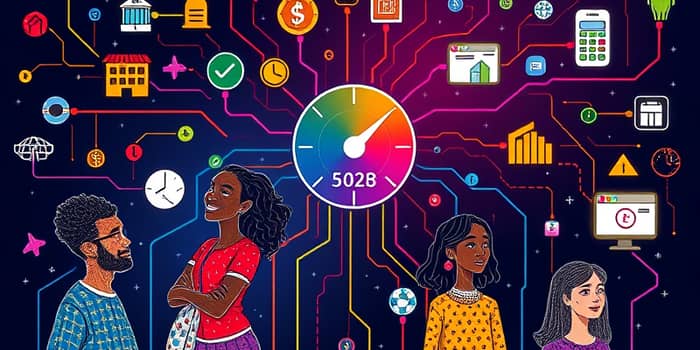
Traditional credit scoring models have been the backbone of lending decisions for decades, yet they often miss the nuances of individual financial journeys. Millions of consumers remain underserved or completely invisible to lenders due to limited borrowing histories. By integrating newer, non-traditional information alongside existing records, lenders can achieve a broader, more equitable view of a person’s creditworthiness.
This article explores how institutions can adopt alternative credit data beyond traditional reports to enhance approval rates, manage risk more effectively, and extend fair opportunities to borrowers of all backgrounds.
Imagine a young immigrant named Maria, who has always paid her rent on time but has never owned a credit card. Under conventional models, Maria remains overlooked, unable to secure a small loan that could help her start a business. By recognizing her consistent rental payments and stable employment, lenders can unlock her entrepreneurial potential and transform her aspirations into reality.
Alternative credit data refers to any financial or behavioral information not typically captured by major credit bureaus. These additional streams offer insights into day-to-day financial habits, allowing lenders to construct a more dynamic profile of applicants. Rather than relying solely on loans and credit cards, institutions can tap into a variety of sources to validate financial responsibility.
These data points capture more than just payment histories; they reveal behavioral patterns and social context. For instance, regular rent payments demonstrate fiscal discipline, while subscription renewals signal reliable budgeting habits. Digital footprints such as e-commerce purchase frequencies and device metadata can even help confirm identity and detect anomalies early.
Some of the most impactful data sources include:
Conventional credit reports are updated infrequently and rely heavily on past borrowing behaviors. This narrow scope excludes many responsible individuals who do not use traditional credit products. In the U.S. alone, around 49 million adults lack a standard credit score, creating a sizable market of “credit invisibles.”
Relying on outdated snapshots recorded monthly can leave lenders blind to sudden changes in a borrower’s financial situation. Missed payments on a small recurring bill may not register on a traditional report until weeks later. This delayed insight can translate into missed opportunities to support responsible customers or mitigate emerging risks.
Furthermore, sole dependence on revolving credit data perpetuates inequality. Those who prefer to avoid debt, use prepaid cards, or manage finances through non-traditional channels are unfairly disadvantaged. By integrating alternative streams, lenders can bridge systemic gaps in credit evaluation and foster a fairer financial ecosystem.
Beyond serving underserved populations, alternative data integration allows lenders to refine underwriting processes and tailor offers more precisely. This approach not only boosts approval rates but also strengthens customer relationships by delivering personalized offerings that reflect true profiles. Such customization fosters trust and encourages long-term loyalty, while driving healthier portfolio performance.
Key benefits include:
By leveraging insights from everyday transactions and non-traditional metrics, institutions can serve millions of credit-invisible consumers, while reducing default rates and optimizing revenue streams.
A clear categorization of data sources helps lenders prioritize integration efforts. Below is a table outlining the most common types, representative examples, and the value each adds to credit models:
Adopting cutting-edge tools is essential to handle massive volumes of unstructured data efficiently. As new sources emerge, traditional data warehouses often struggle to keep pace. By leveraging modern architectures and data processing pipelines, financial institutions can maintain agility and scale their credit models with confidence.
Key enablers include:
These technologies allow lenders to harness complex datasets and continually refine decision engines, enabling dynamic, real-time financial monitoring capabilities and more responsive underwriting.
While alternative data presents significant opportunities, it also introduces new responsibilities. Financial institutions must implement clear consent mechanisms and robust data governance frameworks to safeguard privacy. Transparent communication about how consumer information is used builds trust and aligns with emerging regulatory standards.
Institutions must also maintain transparency by providing applicants with clear explanations of how alternative data affects their credit profiles. Empower consumers through transparent data practices, and engage continuously with consumer advocacy groups and regulators to shape fair policies and promote widespread acceptance.
Transitioning from traditional scoring to a hybrid system requires careful planning. A phased approach ensures stability and compliance at every stage:
This structured roadmap helps financial institutions tailored lending products for unique borrowers and gradually optimize their processes for sustained growth.
By embracing alternative data, lenders have the power to rewrite financial narratives and pave the way for countless success stories. From aspiring entrepreneurs like Maria to gig economy workers, a fuller credit picture dismantle barriers to financial opportunity and opens doors to new possibilities.
The journey toward inclusive finance starts with one strategic choice: recognizing the richness of data that exists beyond the traditional credit bureau. Institutions that act now will lead the transformation toward a fairer, more accurate, and more inclusive credit ecosystem for all.
References













